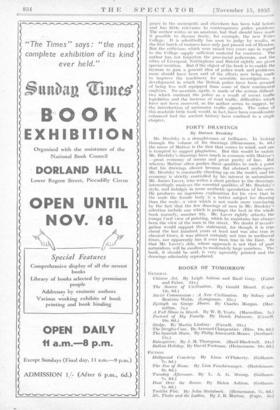FORTY DRAWINGS By Horace Brodzky Mr. Brodzky is a draughtsman
of brilliance. In looking through the volume of his drawings (Heinemann, Ss. 6d.) the name of Matisse is the first that comes to mind, and one is tempted to suggest plagiarism. But this would be unfair. Mr. Brodzky's drawings have much in common with Matisse's —great economy of means and great purity of line. But whereas Matisse often pushes these qualities to such a point that his drawings almost become fiat abstract arabesques, Mr. Brodzky is constantly- checking up on the model, and his economy is strictly controlled by his interest in naturalism. Mr. James Laver,' who writes a short preface to the drawings, interestingly analyses the essential qualities of Mr, Brodzky's style, and indulges in some aesthetic speculation of his own. He produces an ingenious explanation for his view that in the nude the feMale body is a better subject for drawing than the male—a view which is not made more convincing by the fact that the few drawin0 of men in Mr. Brodzky's selection include one which is perhaps the best in the whole book (namely, number 83). Mr. Laver rightly attacks the trompe l'oeil view of painting, which he maintains has always- been the view of the man in the street. • We doubt itinvesti- gation would support this statement, for though it is true about the last hundred years at least and was also true in classical times, it was almost certainly not true in mediaeval times, nor apparently has it ever been true in the East. Sy that Mr. Laver's elite, whoSe approach is- not that of pure naturalism, will be swollen to moderately large numbers. The book, it should be said, is very agreeably printed and the drawings admirably reproduced.










































 Previous page
Previous page